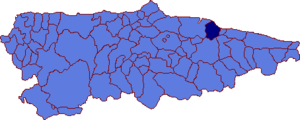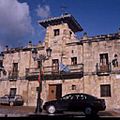Colunga facts for kids
Quick facts for kids
Colunga
|
|||
|---|---|---|---|
|
|||
 |
|||
| Country | |||
| Autonomous community | |||
| Province | Asturias | ||
| Comarca | Oriente | ||
| Judicial district | Villaviciosa | ||
| Capital | Colunga | ||
| Area | |||
| • Total | 97.57 km2 (37.67 sq mi) | ||
| Highest elevation | 1,159 m (3,802 ft) | ||
| Population
(2018)
|
|||
| • Total | 3,332 | ||
| • Density | 34.150/km2 (88.448/sq mi) | ||
| Demonym(s) | colungués / colunguesa | ||
| Time zone | UTC+1 (CET) | ||
| • Summer (DST) | UTC+2 (CEST) | ||
| Postal code |
33320 - 33340
|
||
Colunga is a charming municipality located in the Principality of Asturias, Spain. It sits right on the beautiful Cantabrian Sea. Colunga is bordered by Villaviciosa to the west, Parres and Piloña to the south, and Caravia to the east. It's a place known for its natural beauty and interesting history.
Contents
Areas of Colunga
Colunga is divided into several smaller areas called parishes. Think of them like neighborhoods or small towns within the municipality. Each parish has its own unique character.
- Carrandi
- Colunga
- Gobiendes
- La Isla
- La Llera
- La Riera
- Llastres
- Lliberdón
- Llue
- Pernús
- Pivierda
- Sales
- San Xuan de Duz
The Capital Parish
The main town and capital of the Colunga municipality is also called Colunga. In 2007, about 1,132 people lived there. This main parish is divided into five smaller villages: Cimavilla, El Ferreru, Friera, Loreto, and El Sorriberu.
Population Changes Over Time
The number of people living in Colunga has changed a lot over the years. In the late 1800s and early 1900s, the population was quite high, reaching over 8,000 people around 1920. However, since the mid-20th century, the population has slowly decreased. By 2007, it was around 4,387 people. This kind of change in population is common in many rural areas.
Mystery of the Anchovies
On September 29, 2006, something very unusual happened near Colunga. Millions of anchovies suddenly washed up on the beach! It was a huge amount, weighing over three tons. Scientists tested the dead fish to see if any harmful chemicals caused this. They didn't find any toxins. The most likely idea is that the anchovies were trying to escape from hungry dolphins or tuna. If these anchovies had grown up, they would have been a massive group of fish, weighing more than 100 tons!
Gallery
See also
 In Spanish: Colunga para niños
In Spanish: Colunga para niños










